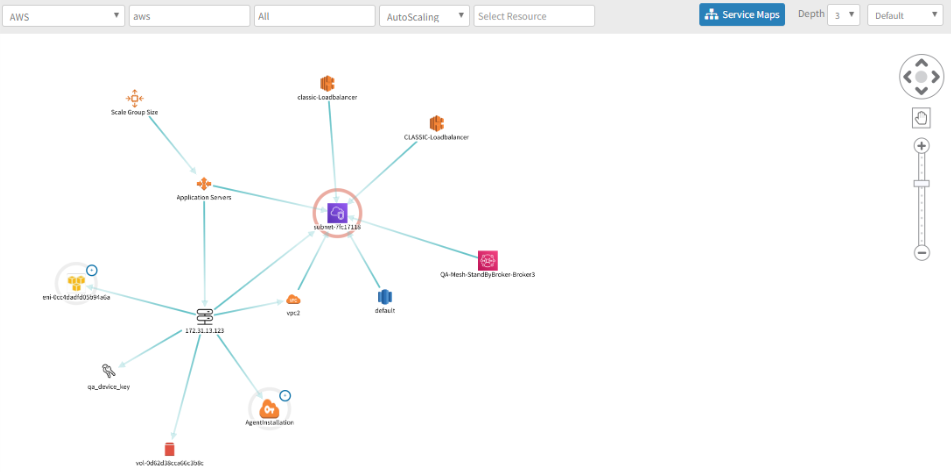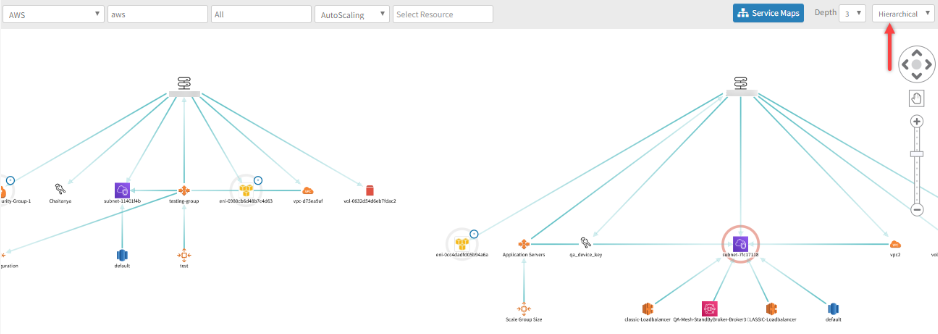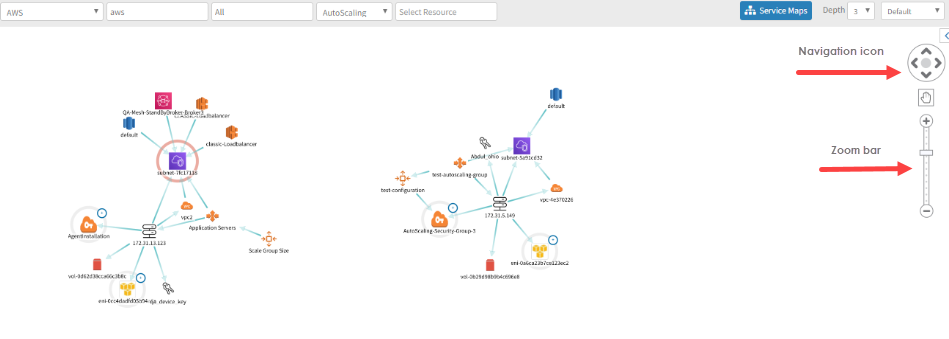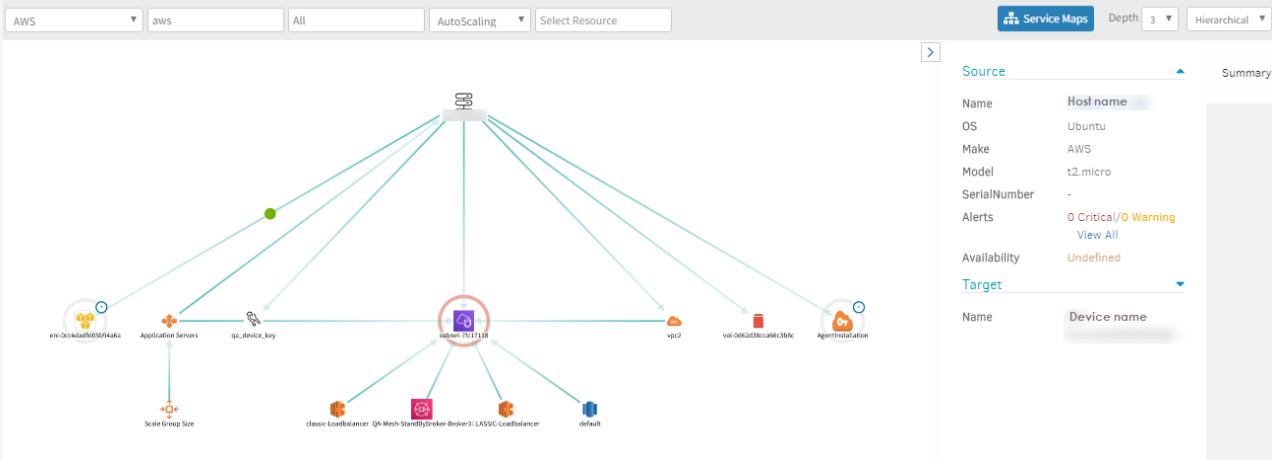Service map overview
Service maps organize services into a hierarchical structure that provides visibility into your services and dependent resources. A service can be an application or an infrastructure service. With service maps, you can:
- Analyze the impact of IT resource on a business service.
- Manage application and infrastructure dependencies.
- View the relationship between resources and services impacting your business.
Service map nodes
Service maps contain nodes that represent a group of services or resources:
- Parent Node: A parent node is the service context (root) node that represents a service.
- Child Node: A child node is the service or resource context node that represents a service or a resource, such as switches, Linux servers, and so on. Resources can only be added to a child node, not to a parent node.
Use cases
Track the health of a service
You might want to track Wi-Fi service availability, which has two components:
- Wireless Controllers
- Wireless Access Points
You want to know:
- Is the service available?
- If the service goes down, which component is causing the fault?
- How much of the service downtime can be attributed to each component?
Solution:
- Create a service map with node Wi-Fi service as the service type and the other nodes as the network resource types.
- Indicate the availability of a Wi-Fi service by defining the availability on Wireless controller and Wireless access points.
- Formulate their health to the overall availability of Wi-Fi service.
When a Wi-Fi service experiences a degradation, it indicates that the components are unavailable.
Identify users impacted by an IT service
For a web application with three components, load balancer, application servers, and database servers, which components impact the web application when the component fails.
Solution:
- Create a node (service group).
- Enter the name of the web application,
- Create another three nodes representing each application component.
- Add resources or services to the nodes.
- Define the availability monitor on the three nodes.
The web application node experiences degradation when any of the three components become unavailable.

Topology explorer overview
Topology explorer is a visual representation of the infrastructure and its connections that displays the health of the infrastructure.
Topology explorer applies to the resources discovered by the OpsRamp Gateway and public cloud, which automatically discover resources and their connections.
OpsRamp supports the following topologies:
- HostName/IPAddress
- AWS
- vCenter
- ESXiHost
- Kubernetes
- Azure
- Resource Group
- Resource UUIDs
Key concepts
Topology explorer shows resources and connected resource dependencies. Topology aggregates related resources into a hierarchical structure and each resource, itself, has a hierarchical structure of its elements.
Vertex (node)
A vertex represents a resource that can directly communicate with other resources over a network, such as a VM instance or an AWS cloud instance. The base, or root, resource is represented as a circular node in the topology explorer and outlined in red.

If you select a resource, the connection between the base resource and the selected resource is highlighted and the other connections fade out. The selected resource is outlined in green.
Edges (connections)
Topology represents connections between the nodes using lines. Topology connects the nodes even if only one side of the connection is communicating.
CDP table
The gateway uses the following CDP data to identify the neighboring nodes:
- The
cdpGlobaltable to identify whether CDP is enabled on the device. - The
cdpCacheEntrytable to identify the resource ID, port, address, cache platform, and capabilities.
LLDP table
The gateway uses the following LLDP data to identify neighboring nodes:
- The
lldpLocalSystemDatatable to identify local chassis ID, local chassis subtype, local system capabilities, and local port description. - The
lldpRemoteSystemsDatato identify remote port description, remote system name, and remote management address.
By querying the OIDs from the CDP or LLDP tables, the gateway identifies the neighbors for one device at a time. Based on the results it repeats the process to fetch the neighbors of the other device. The discovery process ends when the gateway identifies a terminal leaf node or discovery reaches the specified depth.
Data collection and retention
If resources are added or deleted from the network, the resource is not automatically displayed on the map. Topology is displayed according to the scan configured in the Discovery Profile dialog:
- If a periodical scan is configured, resources are displayed at the scheduled time.
- If a manual scan is configured, the network is scanned to add the resources to the map.
The topology explorer UI
You can view resources in the topology explorer UI. Use the map to explore existing configurations and for troubleshooting.
Select any node or connection to display the attributes of that entity.
To expand a node to view the resources represented by the node, double-click the + symbol at the upper-right of the node.
The following sections describe the available functions for viewing the topology map.
Filter
Filters help you search for and focus on specific resources, filtering by site or resource type. Topology explorer shows the filtered resources and connections. For example, you can select the resource type as AWS, select the region, and select the AWS type as Auto Scaling to see the AWS instance and the Auto Scaling resources connected to it in that region.
Depth
Depth refers to the level of topology you want to view. When you have a large number of resources across multiple levels, displaying all resources is impractical. Select the level of topology you want to view for a more comprehensible view. When you first view the topology, all base resources at the hierarchical top-level, Depth 1, are displayed. You can specify view levels up to Depth 5.
Topology layout
Layout refers to resource arrangement with two viewing options available:
The default view provides a radial or hub-and-spoke view of connected resources. This option is preferred for vertices and edges that may not express a direct parent-child hierarchy or strict dependency relationship.

The hierarchical view presents a top-down or parent-child view of resources. This option is best for a strict dependency structure, such as a switch and connected hosts or a router and connected endpoints.

Zoom
You can zoom in and out of the topology map to change the scope of the visualization. When a map is viewed at a low zoom resolution, icons are displayed with a reduced size, the edges are thinner and the label names appear hidden. Labels are displayed when the reduced size of the node is clicked. When a map is viewed at a high zoom resolution, icons are displayed in a larger size, the edges are thicker and label names are displayed. At the default zoom level, icons are displayed at normal resolution, the edges are thicker, and label names are displayed.
Navigate topology explorer
The vertical and horizontal navigation arrows scroll the topology explorer vertically:

View host and target resources
Host and target resource are connected with an edge line. When you select the line, a green dot is displayed indicating the edge was selected. Source and target resource details are also displayed in the Summary panel:

Integrate topology explorer with service maps
You can create Service Maps for entities like HostName/IP Address, AWS, Azure, Google, Hypervisor environment and Kubernetes directly from the respective Topology explorer page.